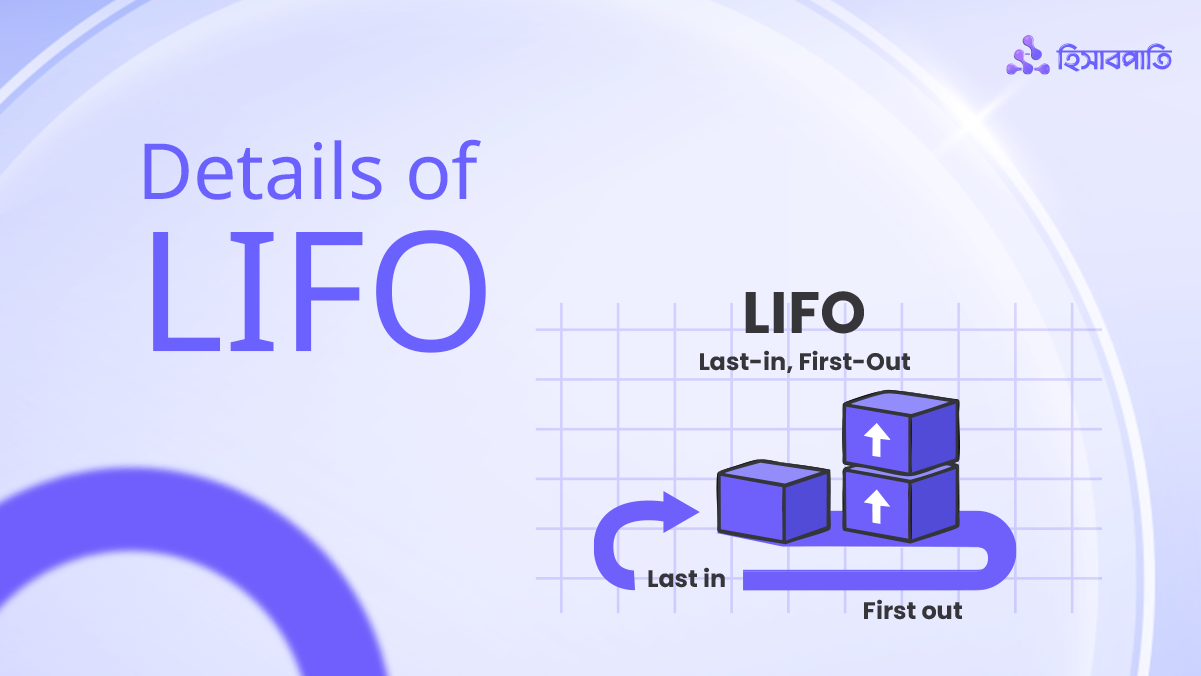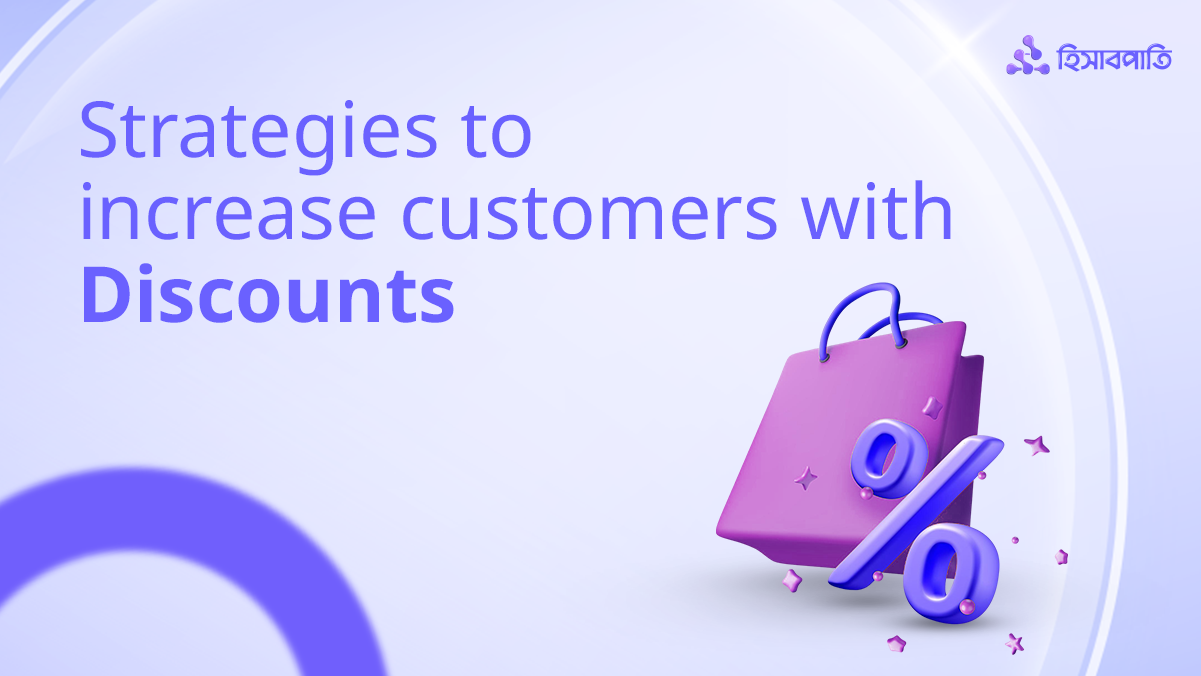In many businesses, when new products are purchased, it is often seen that the newly arrived products are sold first. In accounting terms, this principle is called LIFO method (Last In, First Out). Means the product that arrived last will be sold first..
For small and medium businesses in Bangladesh (such as auto-mobile, hardware, rods-cement, etc.), LIFO can be a practical method. When managing stock in a business, it is very important to keep accurate records of at what price products are sold and how much profit is being made. LIFO (Last In, First Out) is a method in which it is assumed that the products purchased last are sold first.
Advantages of the LIFO method in business-
- It’s easy to understand( the products purchased later are sold first.)
- Stock cost calculation becomes easier.
- It is more effective for products that can be stored for a long time or have a low risk of spoilage.
Let’s now discuss in detail the LIFO method and its use in the HishabPati app.
This blog contains-
In HishabPati, how will a batch or lot be determined?
In business, whenever you purchase products, HishabPati treats each purchase as a separate batch & will be tracked accordingly.
- If you purchase 50 pieces at 100 BDT each for the first time → this will be First Batch
- Next time, if you purchase 50 pieces at 120 BDT each → this will be Second Batch
In this way, every time products are purchased at a new price, they will be recorded as a new batch. In HishabPati, besides purchasing products, you can also add products to stock. For example— By Increasing Stock from Stock Adjustment. If, after the above two purchases, you increase the stock through stock adjustment, it will be added as the third batch.
Similarly, whenever you add a product you can add a purchase price & its initial stock.
When adding a product, if you include the previous stock and purchase price — or even after making several purchases, if you edit the product and add the previous stock — the previous stock will always be added as the first batch.
On HishabPati’s product list page, you can view both the purchase price and the selling price of each product. While using the FLFO policy, you will see the purchase price of the last batch currently in stock.
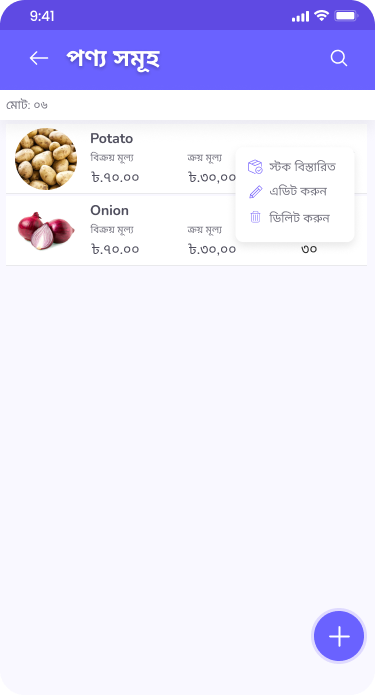
In the web version, you’ll find a stock details icon next to each product. In the app, you can access it by tapping the three-dots icon. When you tap the stock details icon, you’ll be able to see the purchase price and stock quantity of each batch currently in stock.

Those who are using HishabPati already For each of their products, the current stock and the current purchase price will be considered the first batch and its purchase price. Then, when new purchases or stock adjustments are made, those will be recorded sequentially as the second, third, and subsequent batches.
How will profit/loss and stock value be determined under the LIFO policy?
In LIFO policy the cost of goods sold is based on the purchase price of the last batch,followed by the next batches. In other words, products are always sold from the last batch first. Let’s assume you have a single product and its stock is as follows—
- First batch: 100 pieces, purchase price 50 BDT per piece → total cost 5,000 BDT
- Second batch: 100 pieces, purchase price 60 BDT per piece → total cost 6,000 BDT
Total Stock = 200 pieces
Total Stock Value = 5,000 + 6,000 = 11,000 Taka
Then you sold 120 pieces at a selling price of 70 BDT each.
According to the LIFO method, the cost of goods sold (COGS):
- First 100 pieces from the Second batch → 100 × 60 = 6,000 BDT
- Next 20 pieces from the first batch → 20 × 50 = 1,000 Taka
- Total COGS (Cost of Goods Sold) = 6,000 + 1,000 = 7,000 Taka
Sales revenue: 120 × 70 = 8,400 BDT
Profit: 8,400 – 7,000 = 1,400 Taka
After the sale, your remaining stock will be—
- First batch: 80 pieces, purchase price per piece 50 Taka → Total cost = 4,000 Taka
Total Stock Value = 4000 Taka
In this way, the combined total of all your products will be your total stock value. In HishabPati’s stock summary report, you can see the stock value of each product, and by tapping on it, you can view the purchase price and quantity of each batch.
Along with the overall profit or loss, you can see how much profit or loss was made on each sale directly on the sales page.

For security reasons in the Business package, only the owner can view the profit or loss of each transaction.
In HishabPati, you can view the profit and loss report based on sales and also see how the profit was determined. By clicking on “View Details” in this report, you can easily understand which product, from which batch, and how many units were sold.
What happens if you edit a purchase after a sale?
Let’s assume your stock was:
- First batch: 100 pieces, 50 BDT per piece
- Second batch: 80 pieces, 60 BDT per piece
You sold 120 pieces at 70 Taka Sales Price → according to LIFO
- First 80 pieces (60 Taka each)
- Next 40 pieces (50 Taka each)
Profit = 1,600 Taka, remaining stock = 60 pieces (from the 50 Taka batch)
Now, if you If you mistakenly entered the purchase price of the first batch as 50 Taka but then edit that purchase transaction to 55 Taka, here’s what will happen-
- The new stock value of the remaining 60 pieces will be → 60 × 55 = 3,300 Taka
- In the future, when sold, the COGS (Cost of Goods Sold) will be calculated based on the new purchase price.
- The sale made before this edit will remain unchanged. The profit or loss for that sale will stay the same as before.
What happens if you update a sales transaction?
Let’s assume your stock was-
- First batch: 100 pieces, 50 BDT per piece
- Second batch: 80 pieces, 60 BDT per piece
You sold 120 pieces at 70 Taka Sales Price → according to LIFO
- First 80 pieces (60 Taka each)
- Next 40 pieces (50 Taka each)
Profit = 1,600 Taka, remaining stock = 60 pieces (from the 50 Taka batch)
Some examples of editing a sales transaction
1. Change in sales quantity
- For example, the sale changes from 120 → 100 pieces
- 20 pieces will return to stock (to the first batch of 50 Taka, as returned items always go back to the same batch and are valued at that batch’s purchase price).
- The stock value will be updated.
- The profit from the sale will also be updated according to the new calculation.
2. Selling Price Change
- For example, the selling price changes from 70 → 80 BDT per piece.
- COGS will remain the same, but the sales revenue will increase.
- As a result, the profit will increase.
3. Change of product in the sale
- For example, some products were removed or new products were added.
- The stock will automatically decrease or increase according to the respective batches.
- The profit or loss will be updated according to the new calculation.
What happens when a sale is returned under the LIFO (Last In, First Out) method?
Sales Return means—some of the products that were sold earlier are returned by the customer.
- If you process a sales return from a specific sale, under the LIFO method, the returned products will go back into stock at the purchase price of the batch from which they were originally sold.
- If all products from a batch are already out of stock, a new batch will be created in that case.
- And if you do not process the sales return under a specific sale, the returned products will be added to stock at their original purchase price as a new batch.
- Overall sales revenue will decrease due to returned goods.
- Overall profit or loss will be automatically updated according to the new accounts.
- Stock value will also increase accordingly.
What happens when a purchase is returned under the LIFO (Last In, First Out) method?
Purchase return means—you will return the goods you previously purchased to the supplier for any reason and take the money back.
- According to the LIFO method, if a purchase is returned from a specific sale, the returned items go back to the same batch and are valued at that batch’s purchase price.
- If you wish to provide a different purchase price during the purchase return, you can do so, and that will impact the Supplier's party balance. However, the goods will be removed from stock based on the batch's original purchase price, and the cost of the remaining goods in that batch will remain unchanged.
- You can also change this if you wish, by updating the purchase price of that specific purchase transaction.
- And if you do not make a purchase return under a specific purchase, the stock will decrease from the last batch (newest one) according to LIFO.
How can the LIFO (Last-In, First-Out) method be affected by offline use?
Since the HishabPati app can be used offline, you can perform all types of activities, including Purchase and Sales, under the LIFO policy even when offline. Whenever your device comes back online, the data will automatically be transferred to the server. However, some situations may arise in this case.
For Example: when you made a sale offline, it was from a batch with a purchase price of 100 Taka. But before your device came back online, another employee in your organization, using a different device, sold the same product online from that very same batch with the 100 Taka purchase price. In this situation, the product has already been reduced from that batch on the server. When your device returns online, three situations may arise.
- Situation 1: Even though there was an online sale, this batch still has the same amount of product that you sold offline.
- Situation 2: After the online sale, there is not enough product left in this batch for the amount you sold offline, but that amount of product is available in the subsequent batches.
- Situation 3: After the online sale, the amount of product you sold online is not available, even across all batches combined, or there is none at all.
Special provisions in HishabPati for accounting transparency
HishabPati is always committed to maintaining business transparency. For this purpose, two types of icons are used on the right side of each sale in the sales list page—
- One is the purple check mark (✓) icon: This icon means that the transaction, whether done online or offline, has been saved on the server exactly as it was recorded. There is no complication. It will be applicable for situation 1.
- The other one is the yellow exclamation (!) icon: This icon means that the transaction, as recorded offline, could not be synced exactly the same way when going online. Some details are incomplete, and the system will notify you to complete them. It will be applicable for situation 2 & 3.

Tap/click on the yellow exclamation sign to find out what kind of changes have been made or what is incomplete. This will take you to the 'Adjusted Records' page.
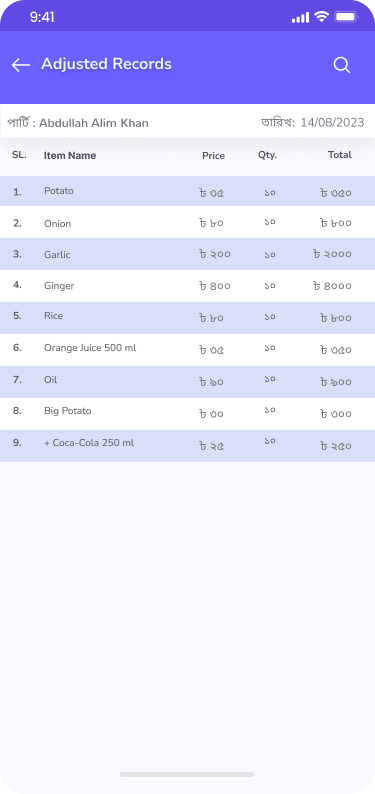
A single transaction may contain many products. The number of products that require adjustment will appear on this page.
Tapping on a specific product in the list will show the details.
If the second situation arises, meaning you sold the product offline but upon coming online, it's found that the required amount of product is not in that specific batch but is available in subsequent batches, then the adjustment will happen automatically from the subsequent batches. You will be able to see that, as shown in the image below.
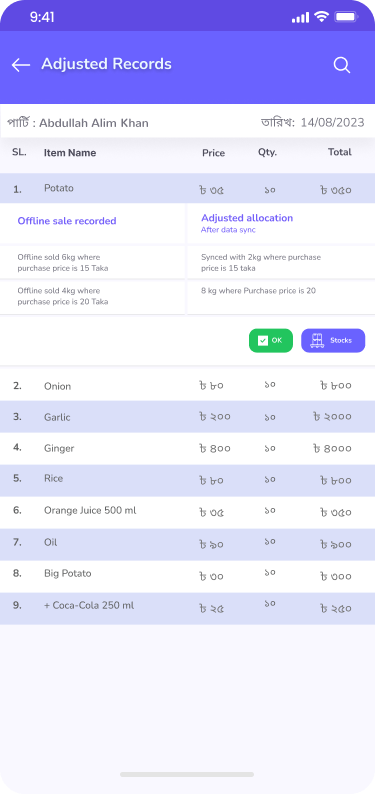
On the left column, you will see the purchase price of the product you sold offline. And on the right, you will see which subsequent batch the adjustment was made from after coming online. Accordingly, the profit-loss of this transaction has also been automatically adjusted. Here you will find two buttons. Tapping OK on the adjustment for all products will turn the yellow exclamation sign next to the transaction into a checkmark.
If the third situation arrived meaning you sold the product offline but upon coming online, it was found that the required amount of product is not in stock, so the adjustment could not be made. The transaction remains in this state. Due to this, the OK button is inactive, and an adjustment button is also inactive.
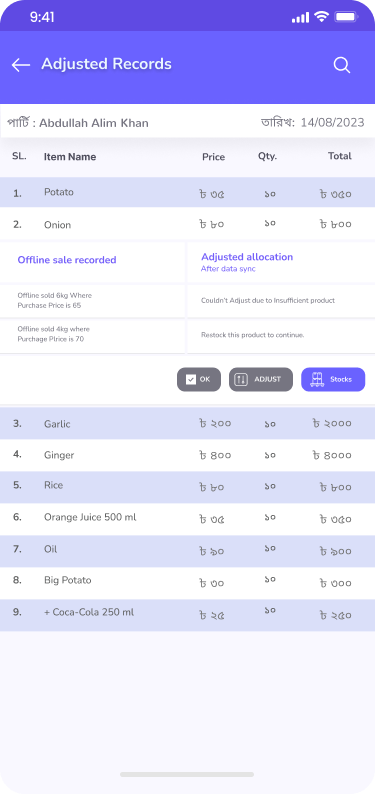
When you add the product back to stock, the adjust button will become active.

Then, as usual, tapping the OK button will change the yellow exclamation mark into a checkmark.
Use LIFO Policy at HishabPati
The LIFO method (Last In, First Out) is one of the reliable ways to keep accounts in business. By using the HishabPati app, business owners can seamlessly apply this method both online and offline. If any changes occur while syncing offline data online, users can clearly see them. Ensure your business reports are always updated and your profit-loss calculations accurate with HishabPati!
Demo - View this & start your journey with HishabPati in three simple steps!
- Step 1: Sign up on HishabPati
First, go to the HishabPati website and create an account for your business. Or, to make managing your business easier, download and install the ‘HishabPati’ app for free today.
Then complete the registration. The registration process in HishabPati is very easy and completely free!
- Step 2: Set up your company
After signing up, first set up your business profile by providing the necessary information as the owner. Then, set up essential business aspects such as inventory, units, purchases and sales, outstanding balances, invoices, and transactions. After that, start updating daily transactions.
- Step 3: Enjoy the various features of HishabPati
Once you start managing your business accounts with HishabPati, make sure to utilize the necessary and unique features, such as invoicing, barcode scanning, units, and expense management. To understand how to use HishabPati and its features in detail, watch demo videos in Bengali on YouTube.
Digital ledger for income and expenses – HishabPati demo.
HishabPati is a simple and affordable accounting app. Its subscription fees are divided into different durations and offered in budget-friendly packages. Check Pricing and Features today in details & choose your desired package. Good luck with your business!

